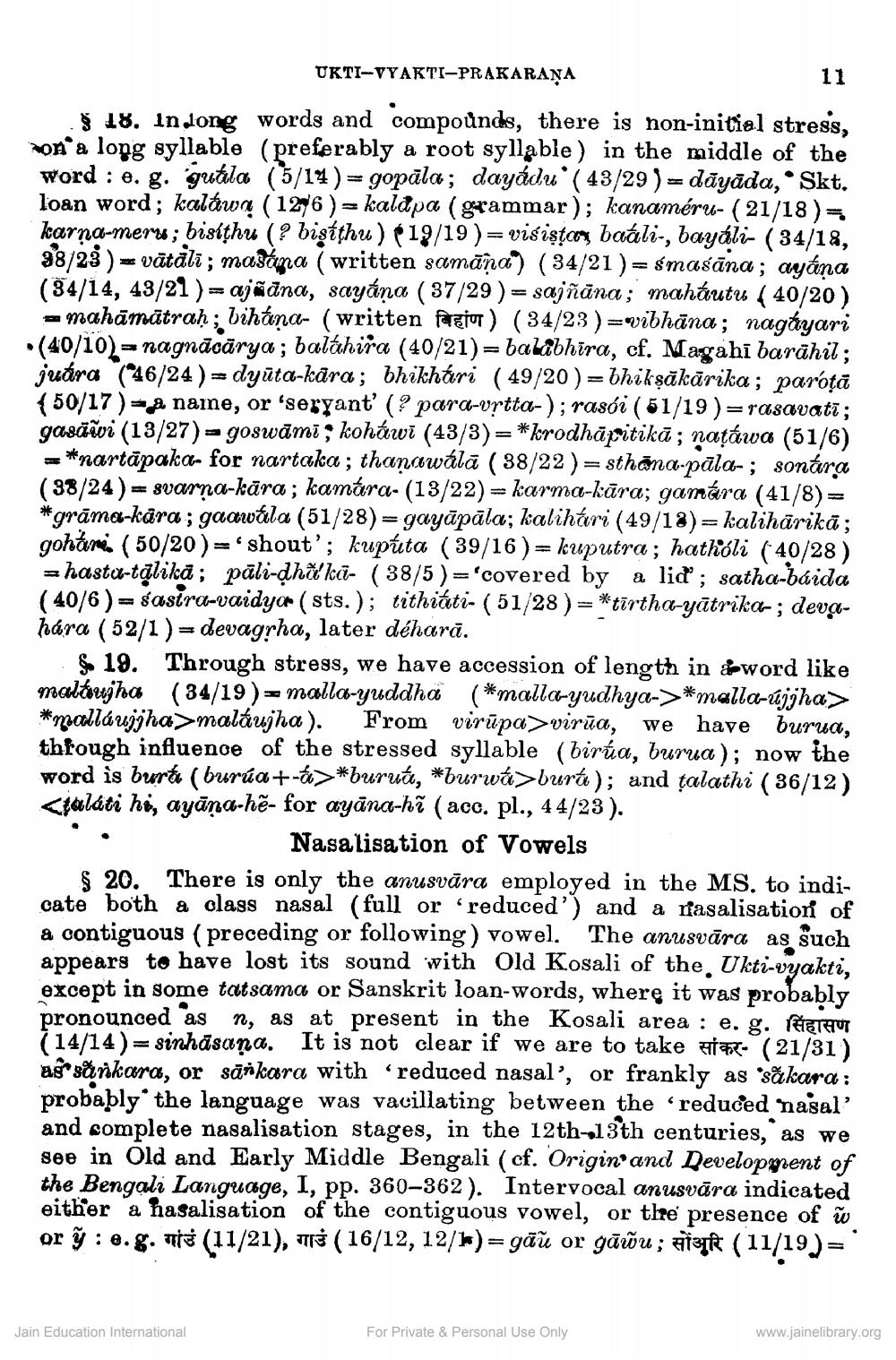________________
UKTI-VYAKTI-PRAKARAŅA
11
.8 18. Indong words and compounds, there is non-initial stress, ron a long syllable (preferably a root syllable) in the middle of the word : e. gi gutala (5/14 )=gopāla; dayádu (43/29 )= dāyāda, Skt. loan word; kaláwą ( 126 ) = kaldpa (grammar); kanaméru- (21/18)= karna-mero; bisithu (? bistthu ) ( 19/19 )= višiştcom baáli-, bayáli- (34/18, 38/28 ) = vātālī; maščina ( written samāņa) (34/21 )= śmasāna; ayána (34/14, 43/21 )= ajñāna, sayána ( 37/29 )= sajñāna; maháutu ( 40/20) - mahāmätrah; bihána- ( written fagio ) (34/23 )=vibhāna; nagáyari (40/10) - nagnācārya ; baláhira (40/21)= balabhīra, cf. Magahī barāhil; juára (146/24)= dyūta-kāra; bhikhtri ( 49/20 )=bhikṣākārika; parotā (50/17 ) = a name, or 'seryant' (? para-vrtta-); rasói ( 51/19 )=rasavatī; gasūãi (13/27) - goswāmi; koháwi (43/3)= *krodhāpitikā; natáwa (51/6) - *nartāpaka- for nartaka ; thanawálā ( 38/22 )=sthāna-pāla-; sontera (38/24 )= svarna-kāra; kamúra- (13/22) = karma-kāra; gamára (41/8)= *grāma-kara; gaawáila (51/28)= gayāpāla; kalihári (49/18)= kalihārikā; gohám. ( 50/20)= 'shout'; kupúta (39/16 )= kuputra; hathóli ( 40/28) =hastu-talikā; päli-dhiki- (38/5 ) ='covered by a liď; satha-báida (40/6 ) = sasira-vaidyar (sts.); tithiáti- ( 51/28 ) = *tirtha-yātrika-; devæhára (52/1) = devagrha, later déharā.
S 19. Through stress, we have accession of length in sword like maltreghco (34/19 ) = mallo-yuddhä (*malla-yudhya->*malla-újja> *mocolláujjha> maláujha). From virūpa>virūa, we have burua, thfough influence of the stressed syllable (birúa, burua); now the word is burti (burúa +-6>*buruk, *burwá>burti); and talathi ( 36/12) <faláti hi, ayāņa-hê- for ayāna-hî (acc. pl., 44/23).
Nasalisation of Vowels § 20. There is only the anusvāra employed in the MS. to indicate both a class nasal (full or reduced') and a riasalisation of a contiguous ( preceding or following) vowel. The anusvāra as such appears to have lost its sound with Old Kosali of the. Ukti-vyakti, except in some tatsama or Sanskrit loan-words, where it was probably pronounced as n, as at present in the Kosali area : e. g. PETANUT (14/14)= sinhāsaņa. It is not clear if we are to take iFR- (21/31 ) ago sărkara, or sārkara with reduced nasal', or frankly as 'săkara : probably the language was vacillating between the reduced nasal' and complete nasalisation stages, in the 12th-13th centuries, as we see in Old and Early Middle Bengali (cf. 'Origin and Development of the Bengali Language, I, pp. 360-362). Intervocal anusvāra indicated either a hasalisation of the contiguous vowel, or thre' presence of w or ģ:e.g. (11/21), TIS (16/12, 12/)= gāù or gūūu ; his (11/19)=
Jain Education International
For Private & Personal Use Only
www.jainelibrary.org




